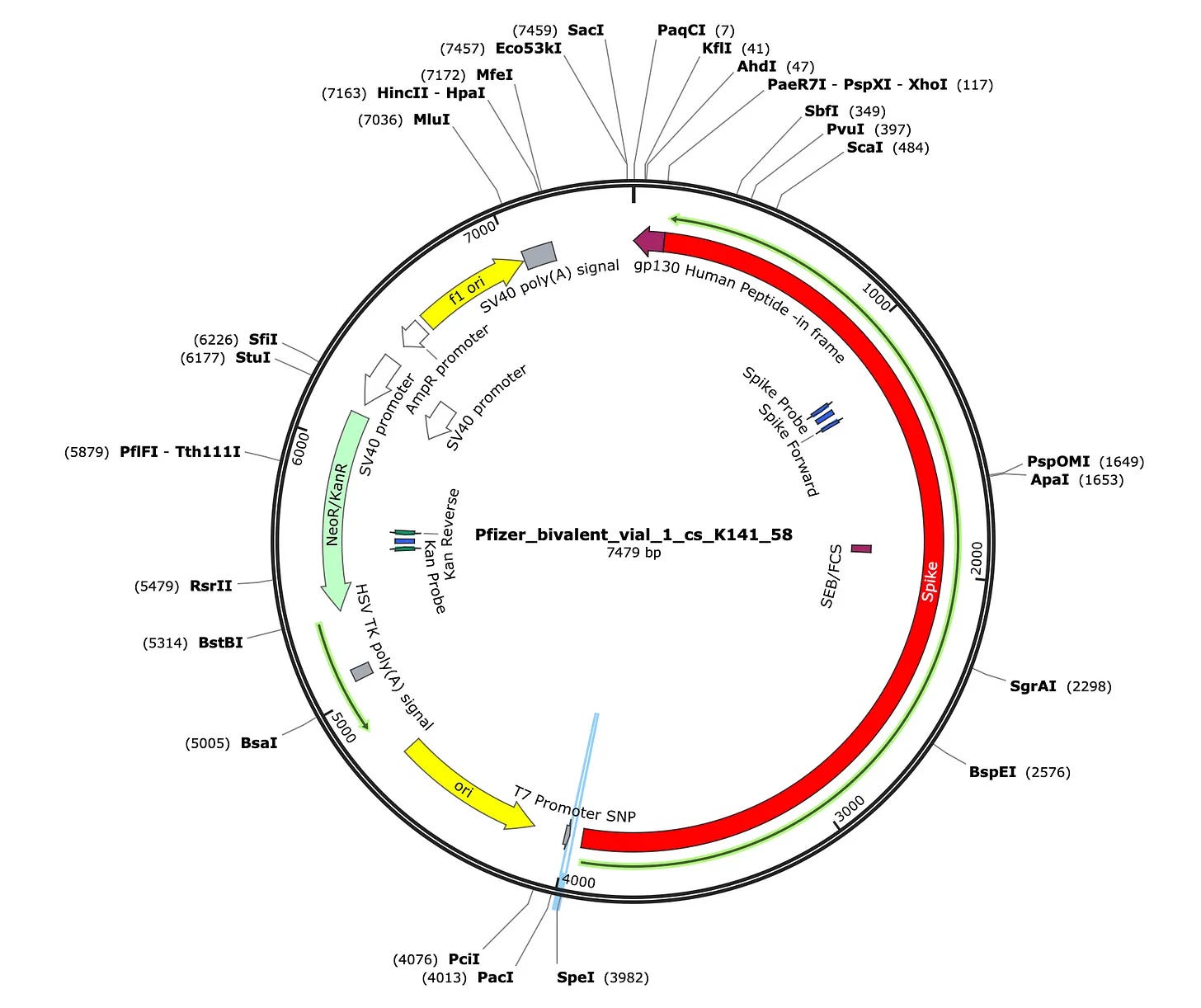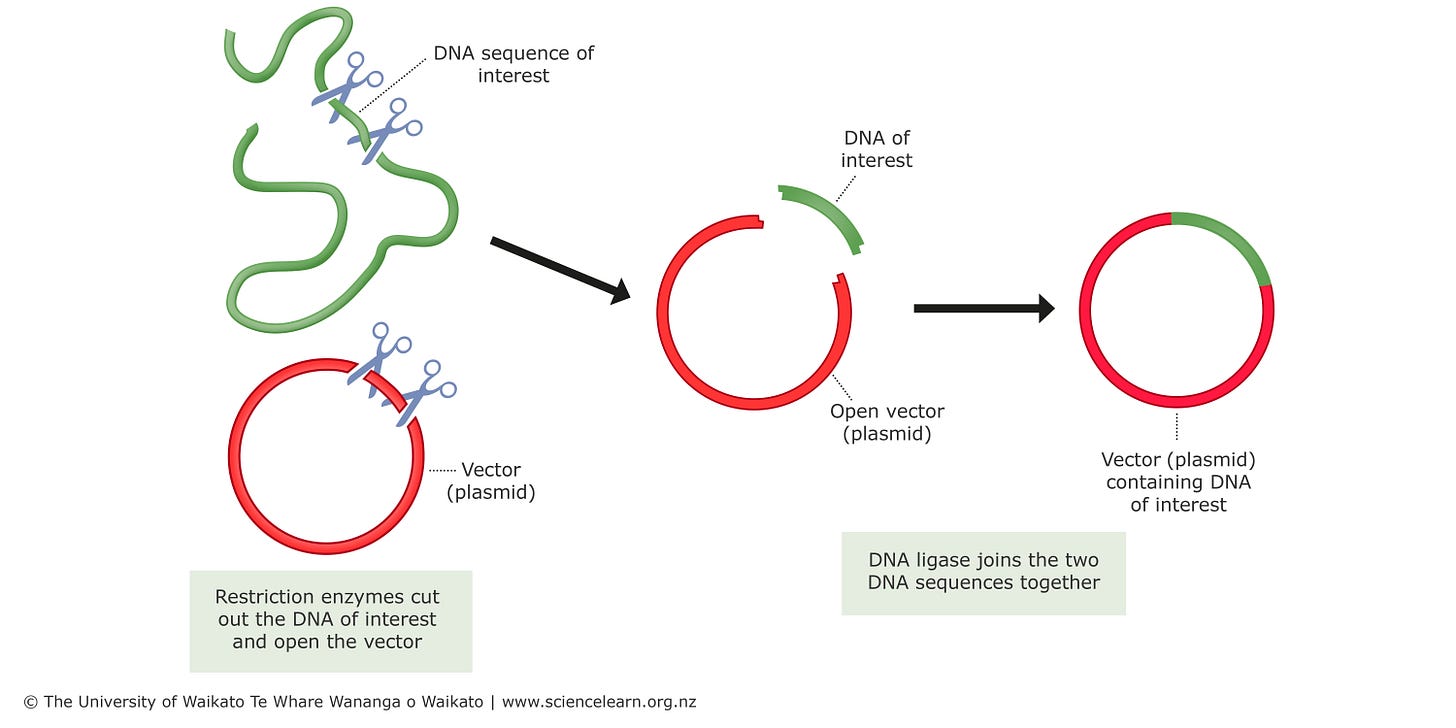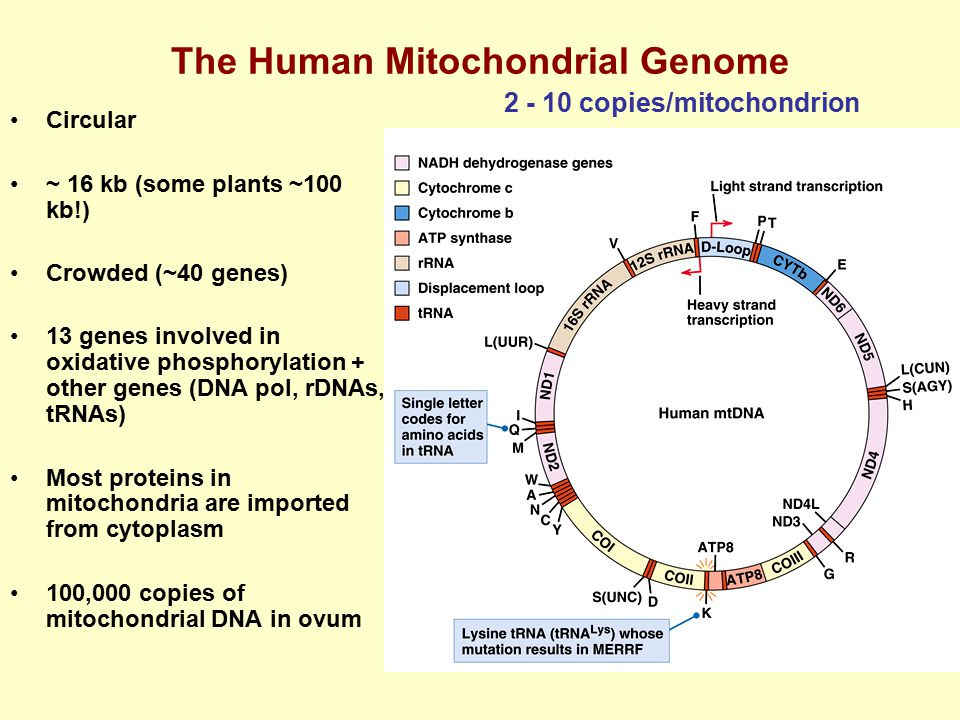Explainer: Expression Vector Contamination & E. Coli
Unlocking Anandamide's excellent Substack on the mRNA quality control issues
Kevin McKernan put together a compelling article that took me a bit of time to appreciate. In short: There are things in the Moderna and Pfizer mRNA vaccines that are not supposed to be there. The vaccines are contaminated with leftover DNA. Some of the DNA is leftover from E. Coli bacteria.
In this article I am taking the great information found in Kevin McKernan’s substack
and bringing it down a level so that more of us can understand and appreciate it. Jessica Rose also did a bit of that in her rendition which can be found HERE.My method for deconstructing this topic. After discussing with Kevin the possibility of doing a "dumb down" of his important work, I first read as many of the comments in the Kevin and Jessica's Substacks and Tweets. I then went to the internet and ChatGPT to try to get information on specific topics (like "what is an "insert"). After I had completed my draft I sent it over to Kevin for his review and edits. My focus is going to be on the opening paragraph. The opening paragraph is concise but dense if you aren’t familiar with some of the basic concepts. So here is the paragraph and then let’s attempt to understand some concepts:
Previous work demonstrated that the Pfizer and Moderna bivalent vaccines are contaminated with the expression vectors used to manufacture the mRNAs. While EMA documents suggest these double stranded DNAs (dsDNAs) are linearized, no data is provided to quantitate this important step. Linear plasmids are less replication competent than circular plasmids. With early estimates of billions of potentially contaminating molecules of DNA, even 99% efficient linearization reactions could still leave millions of replication competent plasmids behind.
This paragraph is shockingly important. But if you don’t know some of the basics, you will miss it. So lets get smart.
Expression Vectors, Plasmids, Inserts & dsDNA
A vector is a piece of DNA that is used to transfer foreign genetic material into another cell.
Expression vectors and plasmids are used in genetic engineering. Expression vectors are man-made DNA molecules that are designed to carry a specific DNA sequence and facilitate its expression in a host cell. For example, if the DNA code is supposed to make a specific protein, the goal is for the expression vector to impact the DNA and result in the eventual expression of that protein.
Plasmids are small, circular DNA molecules found most commonly in bacteria that are used primarily for cloning (like making millions of copies of mRNA for the vaxes) and DNA transfer between cells. A plasmid can replicate independently of the chromosomal DNA in a bacterial cell. (Wait, what do bacteria have to do with this? Hang in there…)
Plasmids are great expression vectors.
Note from Kevin: Humans all have a circular genome known as the 16kb mitochondrial genome. Behaves like a plasmid with an origin of replication.Nerd stuff that will be useful later: Most expression vectors are double-stranded DNA (dsDNA) molecules. The double-stranded nature of the expression vector is important for its stability and replication in the host cell. We will come back to this later, but suffice to say that the double-strand nature better ensures that the vector is properly replicated and passed on to daughter cells.
Furthermore, the double-stranded DNA found in humans is typically linear and less stable and doesn’t replicate as easily; while the dsDNA found in bacteria is circular and tends to be more stable and replicate more easily.
From ChatGPT…
Circular dsDNA is not typically found in the human genome, as the DNA in the nucleus of human cells is linear. However, if circular dsDNA were to enter the human genome, it is possible that it could be more stable and replicate more easily than linear dsDNA.
Circular DNA can be more stable than linear DNA because it lacks free ends that are susceptible to degradation and damage. In addition, circular DNA can sometimes replicate more efficiently than linear DNA because it can undergo rolling-circle replication, a process in which a circular DNA molecule is nicked and one of the strands is used as a template for the synthesis of a new complementary strand.
However, it is important to note that the integration of foreign DNA into the human genome is a complex process and can have significant consequences. If the circular dsDNA contains genes that are beneficial or essential to human cells, it could potentially integrate into the genome and be stably maintained through cell division. However, if the circular dsDNA contains harmful genes or disrupts the regulation of other genes, it could lead to mutations, genomic instability, or disease.More nerd stuff: Plasmids typically contain only basic elements such as an origin of replication, selectable markers, and a multiple cloning site (MCS) for insertion of a DNA fragment of interest. Expression vectors, on the other hand, contain additional elements such as promoters, enhancers, and terminators, which regulate the expression of the gene of interest.
An "insert" generally refers to a piece of DNA that is inserted into an expression vector or plasmid. This piece of DNA can be a gene, a promoter, a regulatory sequence, or any other DNA sequence of interest that researchers want to express or study.
Making your expression vector: At a high level, DNA is inserted into a plasmid, the plasmid is then introduced to the host cell (bacteria, in this case), those bacteria are grown in a way that amplifies the plasmid, and then the plasmid is induced to “express” the desired genetic code.
Let’s read Kevin’s opening paragraph again before we continue to get educated:
Previous work demonstrated that the Pfizer and Moderna bivalent vaccines are contaminated with the expression vectors used to manufacture the mRNAs. While EMA documents suggest these double stranded DNAs (dsDNAs) are linearized, no data is provided to quantitate this important step. Linear plasmids are less replication competent than circular plasmids. With early estimates of billions of potentially contaminating molecules of DNA, even 99% efficient linearization reactions could still leave millions of replication competent plasmids behind.
Okay. We still have a lot more to learn.
EMA & Gene Therapy
The European Medicines Agency (EMA) is responsible for regulating gene therapy products in the European Union.
The EMA evaluates the safety, efficacy, and quality of gene therapy products, and ensures that they meet the necessary regulatory standards before they can be approved for use in the EU. This includes conducting thorough scientific assessments of the data generated through clinical trials and other studies, as well as ensuring that the manufacturing process is appropriate and meets the necessary quality standards.
The EMA has a big job. A big job for a big technology. Ultimately, the EMA has to ensure that gene therapy products are safe and effective for patients in the EU.
Gene therapy involves the use of genetic material to treat or prevent diseases. Therapies might include gene editing, gene transfer, and/or RNA-based therapies. You are essentially modifying or manipulating the genetic material of a person's cells for the purpose of treating or preventing disease.
Our focus here is on RNA-based therapy, which involves using RNA molecules to manipulate gene expression and regulate protein production. The mRNA “vaccines” are RNA-based therapies in that they are trying to get expression of the spike protein by host cells. A Substack I did back in 2021 covers much more on this:
Now, in the context of the mRNA technology, the word “vaccine” has been favored over the phrase “gene therapy.” But don’t be fooled, the mRNA drugs are, in fact, gene therapies.
But are they also vaccines? Well, that is a topic for another day…
Let’s read Kevin’s opener one more time:
Previous work demonstrated that the Pfizer and Moderna bivalent vaccines are contaminated with the expression vectors used to manufacture the mRNAs. While EMA documents suggest these double stranded DNAs (dsDNAs) are linearized, no data is provided to quantitate this important step. Linear plasmids are less replication competent than circular plasmids. With early estimates of billions of potentially contaminating molecules of DNA, even 99% efficient linearization reactions could still leave millions of replication competent plasmids behind.
Getting closer…
Manufacturing, Transcription & Bacteria
Yeah, so if you want to make billions of dollars save the world with gene therapy tech, at some point you need to mass produce the mRNA that goes into the juice that goes into the little vials that then go into arms all over the world.
This part is pretty complicated for the lay person, but I will try to keep it high-level and focus on the interesting parts.
You need DNA to synthesize RNA. mRNA is a subset of RNA. RNA does lots of stuff; mRNA primarily makes proteins.
In genetics, transcription is the process where you get the genetic information that is encoded in DNA copied into a complementary RNA molecule. The RNA molecule can then produce proteins (spike protein, in our case).
Here’s an explainer straight from ChatGPT
During transcription, the DNA double helix is unwound and the RNA polymerase enzyme binds to a specific region of DNA called the promoter. The RNA polymerase then reads the DNA sequence and synthesizes a complementary RNA molecule by adding nucleotides to the growing RNA chain, following the base-pairing rules of A with U, C with G, and so on.
Once the RNA molecule is synthesized, it undergoes processing, which may include the removal of introns (non-coding regions of RNA) and the addition of a cap and tail to the ends of the RNA molecule. The resulting mature RNA molecule, which is identical in sequence to the transcribed portion of the DNA, can then be translated into a protein by the ribosome.So, working backwards, the proteins come from RNA which come from DNA.
Well, we know that the “vaccines” produced by Pfizer and Moderna are vials of ready-to-go mRNA which means that this RNA was produced (manufactured) from DNA somewhere.
Remember, I told you that bacteria would be important.
The most common way to mass-produce mRNA using transcription is through an in vitro transcription (IVT) process. I won’t go into details here, but it normally involves purification and quality control steps that seem to be lacking in the mRNA jab juices.
The most common DNA template used during the in vitro transcription (IVT) process for mass-producing mRNA vaccines is a bacterium plasmid DNA vector.
Said another way, the DNA from plasmids hosted in bacteria are used to mass produce the mRNA found in the jabs. Bacteria is your factory.
So the plasmids are engineered to contain the DNA sequence of interest (that will create the mRNA molecule), including the promoter region and other regulatory elements necessary for efficient transcription of the mRNA molecule.
Factory time: With the plasmid DNA vector introduced into bacterial cells, such as E. Coli, the bacteria are then grown in large fermenters to produce large quantities of plasmid DNA, which is then purified and used as the template for the IVT process to produce the mRNA.
So.
With a better understanding of some of the bits and pieces, we could rewrite Kevin’s first paragraph for the lay person:
The Pfizer and Moderna bivalent vaccines are contaminated with the plasmid expression vectors used to manufacture the mRNAs. These plasmids may be circular (which would be bad) and not linear. While EMA documents suggest these left-over, double-stranded DNAs (dsDNAs) are linearized, and therefore more compatible to proper human controls for foreign DNA, no data is provided to quantitate this important step. Linear plasmids are less stable and less likely to replicate (that’s good, in this case) than circular bacterium plasmids. With early estimates of billions of potentially contaminating molecules of DNA, even if only 1% of competent bacteria plasmids were left behind, that would mean millions ready to replicate in, and possibly integrate with, the human host’s genome.
You can see why this first paragraph is a bombshell. No wonder the genetics community was abuzz.
The bulk of the remainder of the article deals with Kevin’s method for discovering this contamination issue. I won’t get into that part (unless there is enough interest).
Kevin and Jessica both did a second write up to cover poly-A tails, amongst other things. Kevins found HERE; Jessica’s HERE.
But let me briefly highlight the risks of the contaminations.
E. Coli DNA & Endotoxin Contamination
There are three things we need to be concerned with in terms of a poor quality control process and these vaccines.
The leftover plasmids could be be recognized by our bodies as foreign resulting in autoimmune effects or inflammation.
The leftover plasmid DNA could become integrated into our own DNA (did someone say GMO?):
replacing good genetic code and thus resulting in a harm of absence (no longer producing a protein since the plasmid DNA replaced that genetic sequence)
inserting bad genetic code and thus resulting in a harm of addition
Lipopolysaccharide (LPS or endotoxin) contamination which is toxic
The presence of E.coli based plasmids is a canary for Lipopolysaccharide (LPS or endotoxin) contamination. Whenever you see high levels of plasmid contamination derived from gram negative bacteria like E.coli, you should expect high levels of endotoxin contamination. Injecting endotoxin can lead to anaphylaxis and toxic shock syndrome.
Note from Kevin: Usually dsDNA triggers a Type I interferon response independent of what it codes for.Type I interferons are a type of signaling molecule that can activate the immune response. dsDNA does naturally get into cells through viral infection or the breakdown of the cell’s own DNA so human cells are prepared for this. And it doesn’t really matter what the dsDNA is ready to code for, the cell’s innate immune system should recognize it and trigger the production of Type I interferons to wipe out the threat.
Me: So the dsDNA is kind of double edged in terms of what it is capable inside the host’s cell. It is more stable, lasts longer and better at replicating (bad if from bacteria) but also more likely to kick off the T1 Interferon process (good in this case as foreign and potentially harmful to the cell).
Kevin: Yes. Keep in mind, your body is constantly turning over cells which results in dsDNA being spewed into the blood, lymph and gut.
3-6% of the DNA circulating in the maternal blood stream is fetal. This is how we replaced amniocentesis with sequencing. Amnio had a 1:500 kill rate.
https://pubmed.ncbi.nlm.nih.gov/20026875/
Mothers have to have an attenuated immune system to support this but just want to put some context.All that said, the dsDNA contamination exceeds the EMA specifications by several orders of magnitude and is more than likely the result of shoddy quality controls.
Note from Kevin: I don't think STEC E. Coli DNA is any more pathogenic than wild type E. Coli dsDNA. If you can get that DNA to integrate or express, it might be. But that's a long shot. The odds of integration goes up with dsDNA as you don't need to reverse transcribe RNA into DNA before integration.
DNA also persists longer than RNA.Interestingly, two years ago to the day, I covered this bacterial DNA risk in a Tweet (later turned into the Vax Questions substack I referenced above). In it Dr. Vanessa Schmidt Krueger hints at this nightmare scenario.
Of course, the DNA/bacteria issue was low on my list of vax concerns until Kevin did the research and demonstrated it to be a reality.
There is no way to know how big of a problem this is and for how long. More testing is needed.
I hope this has been helpful. Sometimes we just need a little bit of clarity to help some of these articles come alive. I consider this explainer article a work in progress and will continue to edit as I learn more. Please leave comments and I will continue to sharpen this content so that more and more people can get the clarity they desire.
I want to thank Kevin McKernan personally for his help with this Substack. He was very responsive (as usual) with any questions I had.
I would also like to indirectly thank Jessica Rose for her interpretations of Kevin’s material.
If you prefer Twitter to Substack, here is Vax Tweet thread from exactly 2 years ago:












Great stuff! You beat me to the compendium of how to make a shit-ton of mRNA. Still gonna write it up though. :)
Nice work. One thing many people are missing here is (1) the quantity of cDNA/EV/plasmid is very high. It should max out at 3 per 1000 RNA (by weight) according to EMA and international standards, but this is looking to be about 1:2 so about 300 per 1000. Having that much plasmid DNA injected into you is really bad - but it gets worse.
The body can normally eradicate plasmid DNA because it's foreign and the DNAases get to work. But this is wrapped in a fluffy LNP transfectant medium, so will get to every cell that the LNP touches. It will transfect the nucleus of those cells, no problem.
So now you have active EV/plasmid DNA in a LNP available to either produce huge quantities of RNA (because that's what they are there for) or else integrate into the genome - which will happen during cell division even in the absence of a specific integrase enzyme.
The quantity available is the deal breaker because it is now present in the same magnitude of amount as the RNA. They might as well have injected the self-amplifying RNA version that they wanted to from the beginning.
Bear in mind that this analysis is just the bivalent, so it's possible that this was a deliberate contamination knowing that there would be no meaningful QA on the product after the regulators completely failed to do any on the original product.